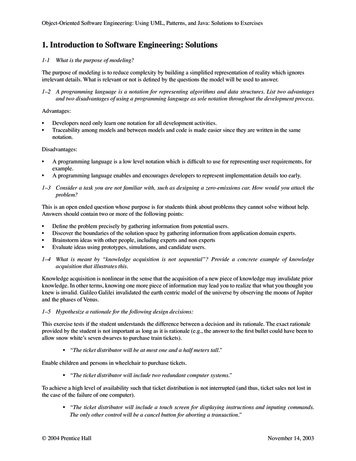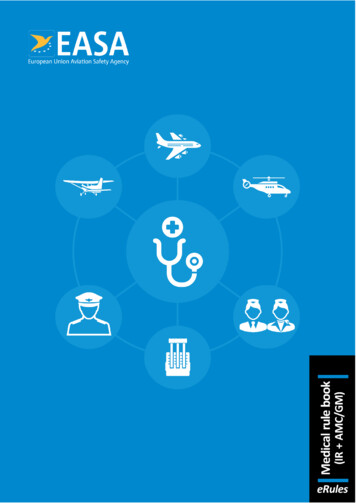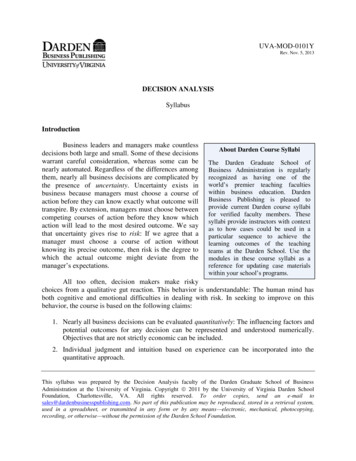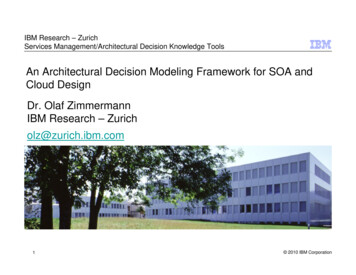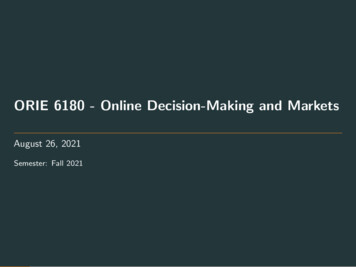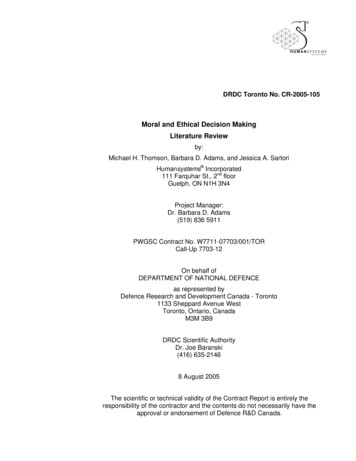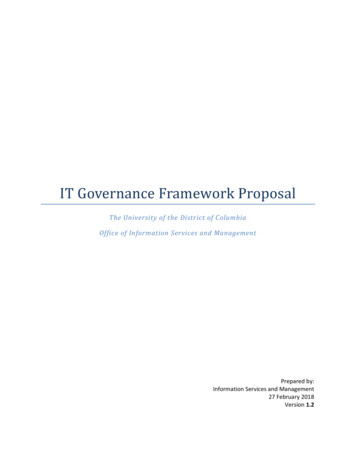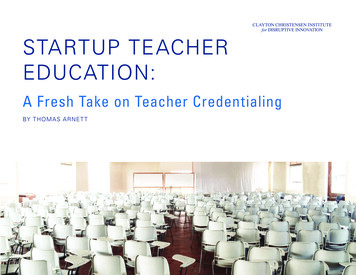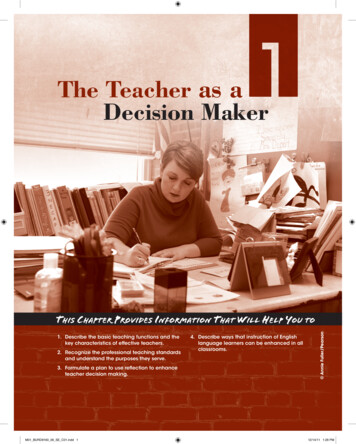
Transcription
1The Teacher as aDecision Maker1. Describe the basic teaching functions and thekey characteristics of effective teachers.2. Recognize the professional teaching standardsand understand the purposes they serve.3. Formulate a plan to use reflection to enhanceteacher decision making.M01 BURD8160 06 SE C01.indd 14. Describe ways that instruction of Englishlanguage learners can be enhanced in allclassrooms. Annie Fuller/PearsonThis ChapTer provides informaTion ThaT Will help You To12/14/11 1:28 PM
2PaRt IFoundations of Teaching MethodsEffEcTivE TEachingDEcIsIons about basIc tEachIngFunctIonsEssEntIal tEachER chaRactERIstIcsExPEctatIons FoR EFFEctIvEnEssYour journey to become a teacher continues. You want to be an effective teacher, but what are the characteristics of effective teachers?What do they need to know and do? To a large extent, effective teaching involves making good decisions to help students learn.Even before instruction takes place, teachers think about and makedecisions concerning content, instructional strategies, the use ofinstructional materials and technology, delivery techniques, class-STanDarDS for TEachErSIntasc stanDaRDsroom management and discipline, assessment of student learning,and a host of other related issues. During instruction, teachers mustimplement these decisions as they interact with students in a dy-PRIncIPlEs oF lEaRnIng anD tEachIngnamic way.FRamEwoRk FoR tEachIngDecision making involves giving consideration to a matter, identify-natIonal boaRD FoR PRoFEssIonaltEachIng stanDaRDsing the desired end result, determining the options to get to the endresult, and then selecting the most suitable option to achieve thedesired purpose. Teacher decisions about the issues just mentionedThE TEachEraS a rEflEcTivEDEciSion MakErultimately will influence student learning.To examine teacher decision making and its relationship to teachingmethods, the discussion in this chapter centers on four questions:REFlEctIonWhat is effective teaching? What are the standards used to guideasPEcts oF InstRuctIonal DEcIsIonmakIngreflective decision maker? How can instruction of English languagethe professional development of teachers? How can a teacher be alearners (ELLs) be enhanced in all classrooms?REFlEctIon anD a constRuctIvIstaPPRoach to tEachIngtools FoR bEcomIng moREREFlEctIvEincrEaSing STuDEnTDivErSiTymoRE EnglIsh languagE lEaRnERschallEngEs oF EnglIsh languagElEaRnERstEachIng EnglIsh languagE lEaRnERsIn all classRoomsthE sIoP moDElEffective TeachingWhat are teachers’ responsibilities, and what makes teachers effectivein meeting these responsibilities? To answer these questions, it is useful to examine the basic teaching functions, essential teacher characteristics, and expectations for effectiveness.DEcIsIons about basIc tEachIng FunctIonsTeachers make countless decisions all day long in an effort to promote student learning. When you break the decisions down, they fallinto three categories: planning, implementing, and assessing. Somedecisions are made at the desk when preparing lesson or unit plans,designing an instructional activity, or grading papers. Other decisions are made on the spot during the dynamic interactions with students when delivering a lesson. Let’s briefly examine these three basicteaching functions. Each will be considered in more detail in laterchapters.Planning. Planning involves teacher decisions about student needs,the most appropriate goals and objectives, the content to be taught,instructional strategies, lesson delivery techniques, instructionalmedia, classroom climate, and student assessment. These decisionsare made before actual instruction takes place. The goal of planningM01 BURD8160 06 SE C01.indd 212/14/11 7:47 AM
chaPtER 1 The Teacher as a Decision Maker3is to ensure student learning. Planning occurs when teachers are alone and have time toreflect and consider issues such as short‐range and long‐range plans, student progress,time available, and instructional materials. Planning helps arrange the appropriate flowand sequence of instructional content and events. Planning is considered in more detailin Chapters 3 and 4.Implementing. Implementing involves the actual enactment of the instructionalplans concerning lesson delivery and assessment. Implementation occurs when interacting with students. Teaching skills that support implementation include presentingand explaining, questioning, listening, monitoring, giving feedback, and demonstrating.Additional skills are needed to monitor student behavior, enforce rules and procedures,use instructional technology, exhibit caring and respect, and create a positive learningenvironment.As you can see, a multitude of skills are required for implementation of the instructional plans, and teachers make decisions constantly during the delivery of instruction toenact those plans and to promote student learning. Several chapters in this book relate toimplementation, including topics such as differentiating instruction for diverse learners,instructional strategies, motivating students, strategies to promote student understanding, managing lesson delivery, and classroom management and discipline.Assessing. Assessing involves determining the level of student learning. Actually, manyaspects of assessment are determined during the planning phase when instructional goalsand content are identified. The means to measure student learning include paper‐and‐pencil tests, portfolios, work samples, projects, reports, journals, models, presentations,demonstrations, and various other types of product and performance assessments. Onceassessment data has been gathered, the information is recorded and judgments are made.Assessment is considered in more detail in Chapters 11 and 12.Teacher decisions about planning, implementing, and assessing matter a great deal.As attempts are made to improve schools and increase student achievement, one constanthas remained: Teachers are the most important factor in improving schools. Attempts toreform or improve education depend on the knowledge, skills, and commitment of teachers. This point is made emphatically by Darling‐Hammond and Baratz‐Snowden (2007)in “A Good Teacher in Every Classroom: Preparing the Highly Qualified Teachers OurChildren Deserve.” Teachers need to know how to implement new practices concerningthe basic teaching functions, but they must also take ownership or the innovation willnot succeed.EssEntIal tEachER chaRactERIstIcsWhen you reflect about the most effective teachers you have had, you may think abouttheir warmth and caring, their creative instructional strategies, their strong command ofthe content, or their unique presentation skills. When examining effective teachers, theessential teacher characteristics fall into three categories: knowledge, skills, and dispositions. Let’s briefly examine each of these. The descriptions provided here are closely tiedto the definitions of those terms provided by the National Council for Accreditation ofTeacher Education (2008).Knowledge. Effective teachers must know the facts about the content they are teaching. That is vital, but it is not sufficient. Teachers also must have at least three other typesof knowledge.First, they must have professional knowledge related to teaching in general. This includes information about the historical, economic, sociological, philosophical, and psychological understanding of schooling and education. It also includes knowledge aboutlearning, diversity, technology, professional ethics, legal and policy issues, pedagogy, andthe roles and responsibilities of the profession of teaching.M01 BURD8160 06 SE C01.indd 312/14/11 7:47 AM
4PaRt IFoundations of Teaching Methodsw h a tWould You decide?DEmonstRatIng YouR EFFEctIvE tEachIngteachers need to have the necessary knowledge, skills, and dispositions to beeffective in the classroom. throughout your teacher preparation program, you willlearn and acquire many of these characteristics. Imagine that you are teachinga lesson in your first year of teaching.1. How would it be evident in your lesson that you have the necessary knowledge,skills, and dispositions to be an effective teacher? What would the studentsobserve in your teaching to identify these qualities?2. What could you do during your teacher preparation program to acquire thesequalities?Second, teachers must have pedagogical knowledge, which includes the general concepts, theories, and research about effective teaching, regardless of the content area. Thus,it involves general teaching methods.Finally, teachers must have pedagogical content knowledge. This involves teachingmethods that are unique to a particular subject or the application of certain strategies ina manner particular to a subject. For example, there may be some unique ways to teachmap reading skills in a social studies class. This also involves a thorough understandingof the content to teach it in multiple ways, drawing on the cultural backgrounds and priorknowledge and experiences of the students.Thus, teachers must possess rich knowledge about the content, foundational information about teaching and learning, information about teaching methods in general, andinformation about teaching techniques unique to particular subjects.Skills. Teachers also must possess the necessary skills to use their knowledge effectivelyin the four areas just described to ensure that all students are learning. Teachers must beable to apply these skills as they plan, implement, and assess in diverse teaching settings.In listings of professional standards, the term performances is sometimes used instead ofthe term skills.Dispositions. Teachers also must have appropriate dispositions to promote learningfor all students. Dispositions include the necessary values, commitments, and professional ethics that influence teacher behaviors. Dispositions are guided by beliefs andattitudes related to values such as caring, fairness, honesty, responsibility, and socialjustice. Dispositions are affective, thus in the mind of teachers. But dispositions showup in teacher behaviors. For example, a teacher might be willing to use a variety ofinstructional strategies to promote learning for all students. This disposition could beevidenced by written plans indicating the use of cooperative learning groups, demonstrations, and a role‐playing activity and by the actual use of those approaches wheninstruction took place.When making decisions, you must have the necessary knowledge, skills, and dispositions to help promote learning for all students. Research has shown that teacher expertiseis one of the most important factors that influences student growth and achievement.There is interest in the educational community to develop criteria for the knowledge,skills, and dispositions that teachers need to promote student achievement.As a prospective teacher, it is important that you identify these essential teacher characteristics (knowledge, skills, dispositions) when you examine the main teaching functionsM01 BURD8160 06 SE C01.indd 412/14/11 7:47 AM
chaPtER 1 The Teacher as a Decision Maker5s a m p l estandardsD e cision Making an D Reflec tionThere are 10 InTASC standards (see pagse xx–xxi), andeach standard in the original document includes a listof performances, essential knowledge, and critical dispositions to indicate more clearly what is intended in thestandard.Since this chapter deals with decision making and reflection, some representative statements from InTASC Standard #9, Professional Learning and Ethical Practice, arelisted here concerning topics in this chapter.PERFoRmancEsThe teacher engages in ongoing learning opportunities to develop knowledge and skills in order to provideall learners with engaging curriculum and learning experiences based on local and state standards. The teacher engages in meaningful and appropriate professional learning experiences aligned with his/her own needs and the needs of the learners, school, andsystem.EssEntIal knowlEDgE The teacher understands and knows how to use avariety of self‐assessment and problem‐solving strategiesto analyze and reflect on his/her practice and to plan foradaptations/adjustments. The teacher knows how to build and implementa plan for professional growth directly aligned with his/her needs as a growing professional using feedback fromteacher evaluations and observations, data on learner performance, and school and systemwide priorities.cRItIcal DIsPosItIons The teacher sees him‐/herself as a learner, continuously seeking opportunities to draw upon current education policy and research as sources of analysis andreflection to improve practice. The teacher understands the expectations of theprofession including codes of ethics, professional standards of practice, and relevant law and policy.of planning, implementing, and assessing. As the teaching functions are discussed in thisbook, several chapters have a boxed feature to indicate the knowledge, skills, and dispositions related to the chapter topic using the descriptions provided in the InTASC standards.For example, Chapter 3 on planning will include a box of information about representativeknowledge, skills, and dispositions related to planning.ExPEctatIons FoR EFFEctIvEnEssOver the years, there have been calls to improve the quality of teaching, the quality andsubstance of the K–12 curriculum, and the performance of students on standardized tests.School districts and teachers always feel some degree of pressure from the local schooldistrict, the state and federal governments, professional organizations, legislators, and thepublic in general. Occasionally, there are major education reports with information aboutstudent performance, and then there are new calls for improving teacher education andthe quality of teaching. Effective teaching is expected.Measures of Effectiveness. Various approaches have been used to indicate the quality of teaching and its influence on student learning. One approach has been to examinestudent achievement test scores over a three‐year time period in a so‐called value‐addedcomparison. This value‐added concept compares the performance of a student againstthat same student’s performance at an earlier time. The difference in the two assessmentsis taken as a measure of student learning growth, which can also be conceptualized asthe value added by the instructional effectiveness of the teacher. Students’ average annualrates of improvement are then used to estimate how much value a teacher has contributedto student achievement (Crane, 2002; Teaching Commission, 2004).M01 BURD8160 06 SE C01.indd 512/14/11 7:47 AM
6PaRt IFoundations of Teaching MethodsA second approach to determining the quality of teaching has involved the study ofteacher test scores and their relationship to the achievement of their students. A series ofstudies correlated teachers’ basic skills tests and college entrance exams with the scoresof their students on standardized tests. These studies have found that high‐scoring teachers are more likely to elicit significant gains in student achievement than their lower‐scoring counterparts (Ferguson, 1998).A third approach to determining the quality of teaching has involved the review of thecontent knowledge of teachers. A teacher’s deep understanding of the content he or sheteaches has a positive influence on student achievement. This appears especially true forscience and mathematics teachers. In a review of research, Michael Allen, program director for the Education Commission of the States (ECS) Teaching Quality Policy Center,found support for the necessity of teachers being knowledgeable in their subjects and onhow best to teach a particular subject (Allen, 2003).In addition, teaching experience appears to have an influence on student achievement. Teachers with less teaching experience typically produce smaller learning gains intheir students compared with more seasoned teachers (Murnane & Steele, 2007). However, most of those studies have also discovered that the benefits of experience level offafter the first five or so years of teaching.No Child Left Behind. While education is often considered a local and state matter,the federal government in the last decade has increased its involvement in how teachers areprepared and certified. This was undertaken through the “highly qualified” teacher provisions of the No Child Left Behind Act (NCLB, 2002). There are several provisions of this act.1. Highly qualified teachers. To be deemed highly qualified, teachers must have abachelor’s degree, have full state certification or licensure, and prove that they know eachsubject they teach.2. State requirements. NCLB requires that states (a) measure the extent to which allstudents have highly qualified teachers, particularly minority and disadvantaged students;(b) adopt goals and plans to ensure that all teachers are highly qualified; and (c) publicly reportplans and progress in meeting teacher quality goals.3. Demonstration of competency. Teachers (in middle and high schools) must prove thatthey know the subject they teach with (a) a major in the subject they teach, (b) credits equivalent to a major in the subject, (c) passage of a state‐developed test, (d) meeting state standardsfor evaluation, (e) an advanced certification from the state, or (f) a graduate degree.4. State standards of evaluation. NCLB allows states to develop a way for current teachersto demonstrate subject‐matter competency and meet highly qualified teacher requirements.These standards must be high, objective, and uniform throughout the state. Proof may consistof a combination of teaching experience, professional development, and knowledge in thesubject garnered over time in the profession.Standards for TeachersEach state identifies the licensure requirements for teachers. The states do not arbitrarilyselect criteria—they often rely on standards proposed by professional educational agencies. The following standards are among those commonly used by states: (a) InTASC standards, (b) Principles of Learning and Teaching (PLT), (c) a Framework for Teaching, and(d) National Board for Professional Teaching Standards (NBPTS). Each of these standards is outlined in detail on pages xx–xxiv of this book.A state may use one of the standards, such as the InTASC standards, and then adaptthem somewhat to serve as the basis for the teacher licensure requirements. Once a stateM01 BURD8160 06 SE C01.indd 612/14/11 7:47 AM
chaPtER 1 The Teacher as a Decision Maker7establishes its teacher licensure requirements, these become the standards that collegesuse to design their teacher education programs. Consequently, you may see that yourteacher education program includes many of the topics listed in the standards. Let’s examine these four sets of standards.Intasc stanDaRDsSponsored by the Council of Chief State School Officers, the Interstate New TeacherAssessment and Support Consortium (INTASC) asked a committee of teachers, teachereducators, and state agency officials to prepare a set of standards for competent beginning teachers. Its 1992 report on model standards served as a guide for states as theydetermined their own teacher licensure requirements. Many states found those standardsappropriate and enacted state licensure requirements that were identical or very similarto the INTASC standards.The InTASC standards were revised in 2011. The new standards are no longer intendedonly for beginning teachers, but as professional practice standards. To reflect this emphasis, InTASC removed “New” from its name (and made the N a lower‐case letter), renaming itself the Interstate Teacher Assessment and Support Consortium (InTASC). The newInTASC Model Core Teaching Standards (Council of Chief State School Officers, 2011)reflect many contemporary goals of education. The model core teaching standards outline what teachers should know and be able to do to ensure every K–12 student reachesthe goal of being ready to enter college or the workforce in today’s world. The standardsoutline the common principles and foundations of teaching practice that cut across allsubject areas and grade levels and that are necessary to improve student achievement.As shown on the table of standards on pages xx–xxi, there are 10 InTASC standardsin four areas: (1) the learner and learning—learner development, learning differences,and learning environments; (2) content knowledge—content knowledge and applicationof content; (3) instructional practice—assessment, planning for instruction, and instructional strategies; and (4) professional responsibility—professional learning and ethicalpractice and leadership and collaboration. For each standard, InTASC outlines the performances, essential knowledge, and critical dispositions for teachers. The identification ofthe dispositions makes the InTASC standards unique when comparing them to standardsidentified by other agencies.PRIncIPlEs oF lEaRnIng anD tEachIngThe Educational Testing Service (ETS) prepared several Praxis II tests to measure theknowledge of specific subjects that K–12 educators will teach, as well as general and subject‐specific teaching skills and knowledge. The three Praxis II tests include Subject Assessments,Principles of Learning and Teaching, and Tests and Teaching Foundations Tests.The Principles of Learning and Teaching (PLT) test assesses general pedagogicalknowledge concerning (a) students as learners, (b) instruction and assessment, (c) communication techniques, and (d) profession and community. These topics are outlined inmore detail in the PLT standards list on page xxi of this book. Many states require applicants for teaching licenses to take the PLT and report a passing score before granting theteaching license. Because of this, colleges with teacher education programs often give agreat deal of attention to the content of the PLT and incorporate the necessary topics intotheir teacher education programs.FRamEwoRk FoR tEachIngThe Educational Testing Service (ETS) developed the Pathwise Series of ProfessionalDevelopment programs as a research‐based approach to advance professional learning andpractice for school leaders and teachers. Charlotte Danielson (2007) worked with ETS toprepare and validate the criteria for this program and then, based on the ETS programM01 BURD8160 06 SE C01.indd 712/14/11 7:47 AM
8PaRt IFoundations of Teaching Methodscriteria, she proposed a framework for teaching in her book Enhancing Professional Practice:A Framework for Teaching.Framework for Teaching is divided into four domains and provides a useful organizer for examining the important responsibilities of teachers. In her book, Danielsonprovides rubrics for each item to assess the level of teacher performance. The rubricdescriptors for unsatisfactory, basic, proficient, and distinguished provide clarity for themeaning of each item. A detailed outline of Danielson’s Framework for Teaching is displayed on page xxii of this book.Many teacher education programs give a great deal of attention to the Framework forTeaching because of its strong research support. As a result, these colleges have incorporated the domains into their teacher education programs. Here is a brief review of the fourdomains in Danielson’s Framework for Teaching.Domain 1: Planning and Preparation. Planning provides a structure for howcontent is organized during the process of planning for instruction. Key concepts withinthis domain are (a) demonstrating knowledge of content and pedagogy, (b) demonstratingknowledge of students, (c) selecting instructional goals, (d) demonstrating a knowledgeof resources, (e) designing coherent instruction, and (f) designing student assessments.Domain 2: Classroom Environment. The classroom environment is more thanjust the physical space of a classroom. It encompasses the interactions between theteacher and students, as well as the expectations for learning and achievement and theexpectations and norms for learning and behavior. Positive classroom environmentsare associated with a range of important outcomes for students related to motivation,achievement, and safety. Key concepts in this domain are (a) creating an environmentof respect and rapport, (b) establishing a culture that promotes learning, (c) managingclassroom procedures, (d) managing student behavior, and (e) organizing physical space.Domain 3: Instruction. Instruction is the central focus of the teaching–learning act.It is where the teacher and the student move through an instructional sequence. Key concepts within this domain are (a) communicating with students, (b) using questioning anddiscussion techniques, (c) engaging students in learning, (d) using assessments in instruction, and (e) demonstrating flexibility and responsiveness.Domain 4: Professional Responsibilities. Professional responsibilities focus onthose dispositions and skills that the teacher uses not only to be effective in the presentbut also to ensure future success as a professional. Central to this domain is the abilityto reflect accurately on the planning process and the implementation of instruction andthen to think deeply about how to improve the teaching–learning process for students.Key concepts within this domain are (a) reflecting on teaching, (b) maintaining accuraterecords, (c) communicating with families, (d) participating in a professional community,(e) growing and developing professionally, and (f) showing professionalism.natIonal boaRD FoR PRoFEssIonaltEachIng stanDaRDsThe National Board for Professional Teaching Standards (NBPTS) was initiated in1987 to establish “high and rigorous” standards for the teaching profession, create a voluntary system to certify accomplished teaching, create professional development opportunities, and increase the status of the teaching profession in America. The board’s workis guided by five core propositions that articulate what accomplished teachers shouldknow and be able to do (NBPTS, 2005). These core propositions are used as a foundationto assess teaching in a variety of subjects and for teachers working with students at allgrade levels.M01 BURD8160 06 SE C01.indd 812/14/11 7:47 AM
chaPtER 1 The Teacher as a Decision Maker9Details for the five core propositions are outlined on pages xxiii–xxiv. Briefly stated,the NBPTS core propositions are as follows:1. Teachers are committed to students and their learning.2. Teachers know the subjects they teach and how to teach those subjects to students.3. Teachers are responsible for managing and monitoring student learning.4. Teachers think systematically about their practice and learn from experience.5. Teachers are members of learning communities.These five core propositions describe the knowledge, skills, and dispositions that characterize accomplished teaching. Because of the recognized importance of these criteria,many teacher education programs incorporate features of the five core propositions intheir programs.Experienced teachers choosing to be nationally board certified must prepare portfolios and include a videotape of their teaching, provide samples of student learning products, and provide analyses and reflection on their professional practice. A central goal ofthe NBPTS assessment process is to improve teacher performance through the collectionof evidence of teaching excellence. After completion of the portfolio, teachers travel to anassessment center where they answer questions related to the subject area in which theyteach. This rigorous process is voluntary. Some school districts provide a financial bonusfor teachers who become certified through this process.The Teacher as a ReflectiveDecision MakerWhen teachers examine and reflect on their teaching, it opens a door to personal and professional development. The ultimate goal, of course, is to promote student learning, andteacher reflection is one way to achieve that goal. In this section, we examine reflectionfrom several perspectives, aspects of instructional decision making, reflection as part of aconstructivist way to teaching, and tools for becoming more reflective.REFlEctIonTo learn requires that a person reflect on past practice. As a consequence, reflection aboutone’s experiences is a cornerstone of professional competence (York‐Barr, Sommers,Ghere, & Montie, 2006). Reflection can be defined as a way of thinking about educationalmatters that involves the ability to make rational choices and to assume responsibility forthose choices. Reflection requires that teachers be introspective, open‐minded, and willing to accept responsibility for decisions and actions. Reflection facilitates learning andcontinued professional growth, and it is an important factor in the ability of teachers tobe effective throughout their careers (Steffy, Wolfe, Pasch, & Enz, 2000). Educators canreflect on many things, such as their dispositions, objectives, teaching strategies, and theeffect each of these factors have on student achievement.As reflective practitioners, teachers need to be willing to analyze their own traits andbehaviors in relation to the events that take place in the classroom. Teachers, therefore,need to observe and attempt to make sense of situations by checking their insights againstprior experience. Information they receive from their students can also be helpful.Some schools arrange for two or more teachers to meet to address issues and reflecton their practice. Reflective practice is a problem‐solving strategy by which individuals or groups can work to improve practice by reviewing routines and the proceduresand other aspects of the instructional environment. To engage in reflective practiceM01 BURD8160 06 SE C01.indd 912/14/11 7:47 AM
10Part IFoundations of Teaching Methodsrequires an environment of support. It requires an organizational climate that encourages open communication, critical dialogue, risk taking, and collaboration (Osterman &Kottkamp, 2004).We next examin
book, several chapters have a boxed feature to indicate the knowledge, skills, and disposi-tions related to the chapter topic using the descriptions provided in the InTASC standards. For example, Chapter 3 on planning will include a box of information about representative knowledge, skills, and dispositions related to planning.

